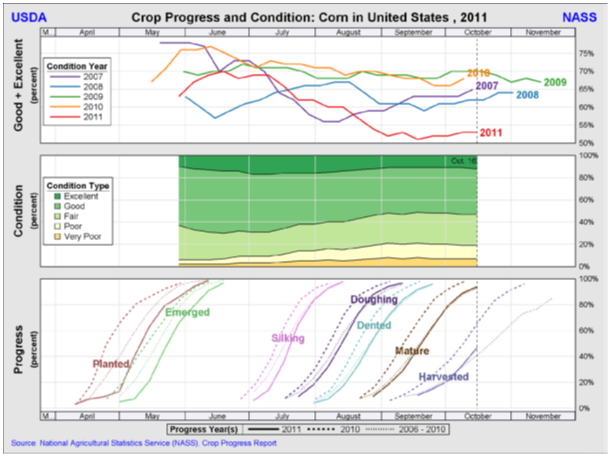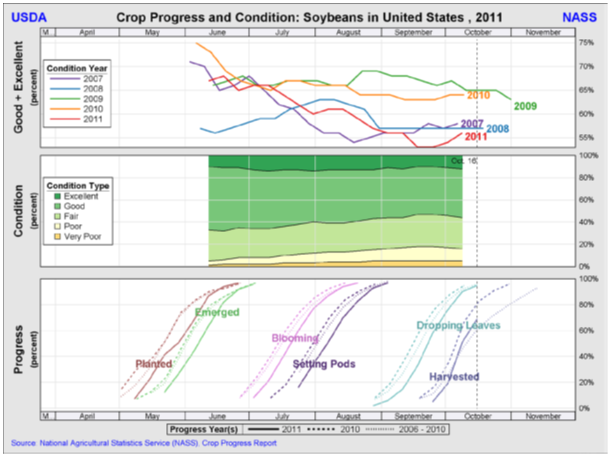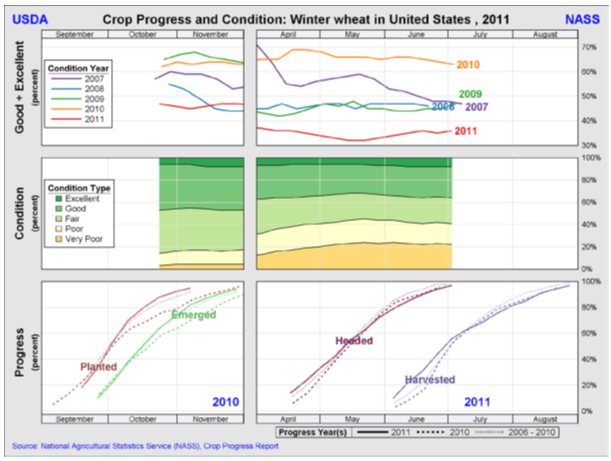Analys
SHB jordbrukskommentar vecka 42 2011
 Vete
Vete
Terminspriser på vete stängde igår torsdag i stort sett oförändrat sedan förra veckan. Det är fortsatt torrt för det amerikanska höstvetet, både för sådd och uppkomst vilket ger skäl till viss oro. I Argentina behövs också mer nederbörd medan EU överlag uppges ha ett tillfredställande väder. Som följd av torka bedöms endast 85 procent av den planerade vetearealen ha blivit sådd i Ukraina och uppkomsten uppges dessutom vara väldigt ojämn. I Ryssland är däremot vädret mer fördelaktigt och sådden uppges gå relativt bra. Ukrainas president har nu skrivit under avtalet om att ta bort landets exportskatter på spannmål. Landets jordbruksminister uttalade sig dessutom i veckan om att den totala spannmålsexporten under säsongen 2011/12 mycket väl kan nå 27 miljoner ton – 3 mil-joner ton över föregående prognos. Viss oro finns alltså för höstvetet i USA, och osäkerheten finns fortfarande kvar vad gäller den amerikanska majsskörden, men det är ändå svårt att se en prisuppgång på vete för tillfället. Konkurrensen kommer öka från Ukraina och även från Kazakstan och både EU och USA lär ha svårt att vinna affärer på exportmarknaden. Det ska dock tilläggas att de forna sovjetländerna ofta får problem med logistiken under vintermånaderna.
Raps
Terminspriset på raps är i stort sett oförändrat jämfört med förra veckan och har visat sig stark då sojan i Chica-go gått ned. EU:s rapsskörd säsongen 2011/12 uppskattas till 19 miljoner ton, 1,5 miljoner ton mindre än förra säsongen. Importen beräknas till omkring 3 miljoner ton och utgående lager till 1 miljon ton. Den ukrainska höstrapsarealen beräknas ha blivit ungefär 4 procent mindre än väntat som följd av torka, dessutom bedöms skicket på grödan vara ganska dåligt. Gynnsamt regn i Australien har lett till att landets skörd av canola nu upp-skattas till rekordhöga 2,56 miljoner ton. Viss oro finns för nyligen sådd raps i Tyskland, Danmark, Rumänien och Bulgarien. Fortsatt stark efterfrågan bör ge stöd åt priser på lite längre sikt, medan priserna för tillfället på-verkas mycket av en ökad eller minskad oro för ekonomiska problem i främst Europa.
Maltkorn
Terminspriset på maltkorn är i stort sett oförändrat sedan förra veckan. Förhållandet mellan utbud och efterfrågan på maltkornsmarknaden är fortsatt ansträngd – det återstår att se om Australien och Argentina kan förändra detta. Rysslands kornskörd uppskattas i år till mellan 16 och 17 miljoner ton, men endast en liten del klarar kvalitetskraven för maltkorn – främst är det problem med för hög proteinhalt. Ungefär 5-10 procent av maltkorns-skörden i Skottland återstår, kvaliteten uppges där vara förvånansvärt hög.
Majs
Majsen i Chicago har gått upp något under veckan, inte minst som följd av skörderapporter som fortsätter visa att USDA överskattar avkastningsnivån på den amerikanska skörden. Torrt väder råder i Argentina och nederbörd behövs för sådd och uppkomst. I tisdags uppgavs 32 procent av den argentinska majsen vara sådd – att jämföra med förra årets 46 procent vid samma tidpunkt.
USDA crop progress 17 oktober
Sojabönor
Sojapriserna har i veckan fått viss press nedåt som följd av oron för den globala ekonomin och vinsthemtagning efter föregående veckas uppgång. Lite regn i veckan har saktat ner skördearbetet i USA något, men skörden är fortfarande ovanligt långt kommen – vilket även det gett viss press nedåt. Samtidigt fortsätter skörderapporter vittna om en lägre amerikansk skörd än vad USDA anger i sin senaste rapport, det bör begränsa en eventuell fortsatt nedgång.
USDA crop progress 17 oktober
Majs
Majsen mognar snabbt och 94 procent av grödan uppgavs i måndags vara klar för skörd, upp från 89 procent i föregående vecka och något mer än genomsnittet för de senaste fem åren om 93 procent. Förra året var 100 procent av grödan mogen.
47 procent av majsskörden uppgavs vara avklarad, upp från förra veckans 33 procent. Klart efter 66 procent vid samma tidpunkt förra året men över genomsnittet för de senaste fem åren om 41 procent.
Andelen av majsen som beräknades vara i skicket ”good/excellent” uppgavs till 53 procent, oförändrat från före-gående vecka. Andelen av grödan som bedöms vara i skicket ”poor/very poor” var oförändrad med 19 procent.
Sojabönor
Skörden uppges vara till 69 procent avklarad, jämfört med 51 procent förra veckan. Vid samma tid förra året var 81 procent skördat, och genomsnittet för de senaste fem åren är 61 procent.
Höstvete
Sådden av höstvete i USA var enligt måndagens rapport avklarad till 73 procent, upp från 59 procent en vecka tidigare. Vid samma tid förra året var 80 procent av sådden avklarad, mot genomsnittet för de senaste fem åren om 77 procent.
44 procent av vetet uppges ha nått uppkomststadiet, jämfört med 28 procent förra veckan. Vid samma tid förra året hade 50 procent av höstvetet nått uppkomst och genomsnittet för de senaste fem åren är 51 procent.
[box]SHB Råvarubrevet är producerat av Handelsbanken och publiceras i samarbete och med tillstånd på Råvarumarknaden.se[/box]
Ansvarsbegränsning
Detta material är producerat av Svenska Handelsbanken AB (publ) i fortsättningen kallad Handelsbanken. De som arbetar med innehållet är inte analytiker och materialet är inte oberoende investeringsanalys. Innehållet är uteslutande avsett för kunder i Sverige. Syftet är att ge en allmän information till Handelsbankens kunder och utgör inte ett personligt investeringsråd eller en personlig rekommendation. Informationen ska inte ensamt utgöra underlag för investeringsbeslut. Kunder bör inhämta råd från sina rådgivare och basera sina investeringsbeslut utifrån egen erfarenhet.
Informationen i materialet kan ändras och också avvika från de åsikter som uttrycks i oberoende investeringsanalyser från Handelsbanken. Informationen grundar sig på allmänt tillgänglig information och är hämtad från källor som bedöms som tillförlitliga, men riktigheten kan inte garanteras och informationen kan vara ofullständig eller nedkortad. Ingen del av förslaget får reproduceras eller distribueras till någon annan person utan att Handelsbanken dessförinnan lämnat sitt skriftliga medgivande. Handelsbanken ansvarar inte för att materialet används på ett sätt som strider mot förbudet mot vidarebefordran eller offentliggörs i strid med bankens regler.
Finansiellt instruments historiska avkastning är inte en garanti för framtida avkastning. Värdet på finansiella instrument kan både öka och minska och det är inte säkert att du får tillbaka hela det investerade kapitalet.
Analys
Tightening fundamentals – bullish inventories from DOE

The latest weekly report from the US DOE showed a substantial drawdown across key petroleum categories, adding more upside potential to the fundamental picture.

Commercial crude inventories (excl. SPR) fell by 5.8 million barrels, bringing total inventories down to 415.1 million barrels. Now sitting 11% below the five-year seasonal norm and placed in the lowest 2015-2022 range (see picture below).
Product inventories also tightened further last week. Gasoline inventories declined by 2.1 million barrels, with reductions seen in both finished gasoline and blending components. Current gasoline levels are about 3% below the five-year average for this time of year.
Among products, the most notable move came in diesel, where inventories dropped by almost 4.1 million barrels, deepening the deficit to around 20% below seasonal norms – continuing to underscore the persistent supply tightness in diesel markets.
The only area of inventory growth was in propane/propylene, which posted a significant 5.1-million-barrel build and now stands 9% above the five-year average.
Total commercial petroleum inventories (crude plus refined products) declined by 4.2 million barrels on the week, reinforcing the overall tightening of US crude and products.


Analys
Bombs to ”ceasefire” in hours – Brent below $70

A classic case of “buy the rumor, sell the news” played out in oil markets, as Brent crude has dropped sharply – down nearly USD 10 per barrel since yesterday evening – following Iran’s retaliatory strike on a U.S. air base in Qatar. The immediate reaction was: “That was it?” The strike followed a carefully calibrated, non-escalatory playbook, avoiding direct threats to energy infrastructure or disruption of shipping through the Strait of Hormuz – thus calming worst-case fears.

After Monday morning’s sharp spike to USD 81.4 per barrel, triggered by the U.S. bombing of Iranian nuclear facilities, oil prices drifted sideways in anticipation of a potential Iranian response. That response came with advance warning and caused limited physical damage. Early this morning, both the U.S. President and Iranian state media announced a ceasefire, effectively placing a lid on the immediate conflict risk – at least for now.
As a result, Brent crude has now fallen by a total of USD 12 from Monday’s peak, currently trading around USD 69 per barrel.
Looking beyond geopolitics, the market will now shift its focus to the upcoming OPEC+ meeting in early July. Saudi Arabia’s decision to increase output earlier this year – despite falling prices – has drawn renewed attention considering recent developments. Some suggest this was a response to U.S. pressure to offset potential Iranian supply losses.
However, consensus is that the move was driven more by internal OPEC+ dynamics. After years of curbing production to support prices, Riyadh had grown frustrated with quota-busting by several members (notably Kazakhstan). With Saudi Arabia cutting up to 2 million barrels per day – roughly 2% of global supply – returns were diminishing, and the risk of losing market share was rising. The production increase is widely seen as an effort to reassert leadership and restore discipline within the group.
That said, the FT recently stated that, the Saudis remain wary of past missteps. In 2018, Riyadh ramped up output at Trump’s request ahead of Iran sanctions, only to see prices collapse when the U.S. granted broad waivers – triggering oversupply. Officials have reportedly made it clear they don’t intend to repeat that mistake.
The recent visit by President Trump to Saudi Arabia, which included agreements on AI, defense, and nuclear cooperation, suggests a broader strategic alignment. This has fueled speculation about a quiet “pump-for-politics” deal behind recent production moves.
Looking ahead, oil prices have now retraced the entire rally sparked by the June 13 Israel–Iran escalation. This retreat provides more political and policy space for both the U.S. and Saudi Arabia. Specifically, it makes it easier for Riyadh to scale back its three recent production hikes of 411,000 barrels each, potentially returning to more moderate increases of 137,000 barrels for August and September.
In short: with no major loss of Iranian supply to the market, OPEC+ – led by Saudi Arabia – no longer needs to compensate for a disruption that hasn’t materialized, especially not to please the U.S. at the cost of its own market strategy. As the Saudis themselves have signaled, they are unlikely to repeat previous mistakes.
Conclusion: With Brent now in the high USD 60s, buying oil looks fundamentally justified. The geopolitical premium has deflated, but tensions between Israel and Iran remain unresolved – and the risk of missteps and renewed escalation still lingers. In fact, even this morning, reports have emerged of renewed missile fire despite the declared “truce.” The path forward may be calmer – but it is far from stable.
Analys
A muted price reaction. Market looks relaxed, but it is still on edge waiting for what Iran will do

Brent crossed the 80-line this morning but quickly fell back assigning limited probability for Iran choosing to close the Strait of Hormuz. Brent traded in a range of USD 70.56 – 79.04/b last week as the market fluctuated between ”Iran wants a deal” and ”US is about to attack Iran”. At the end of the week though, Donald Trump managed to convince markets (and probably also Iran) that he would make a decision within two weeks. I.e. no imminent attack. Previously when when he has talked about ”making a decision within two weeks” he has often ended up doing nothing in the end. The oil market relaxed as a result and the week ended at USD 77.01/b which is just USD 6/b above the year to date average of USD 71/b.

Brent jumped to USD 81.4/b this morning, the highest since mid-January, but then quickly fell back to a current price of USD 78.2/b which is only up 1.5% versus the close on Friday. As such the market is pricing a fairly low probability that Iran will actually close the Strait of Hormuz. Probably because it will hurt Iranian oil exports as well as the global oil market.
It was however all smoke and mirrors. Deception. The US attacked Iran on Saturday. The attack involved 125 warplanes, submarines and surface warships and 14 bunker buster bombs were dropped on Iranian nuclear sites including Fordow, Natanz and Isfahan. In response the Iranian Parliament voted in support of closing the Strait of Hormuz where some 17 mb of crude and products is transported to the global market every day plus significant volumes of LNG. This is however merely an advise to the Supreme leader Ayatollah Ali Khamenei and the Supreme National Security Council which sits with the final and actual decision.
No supply of oil is lost yet. It is about the risk of Iran closing the Strait of Hormuz or not. So far not a single drop of oil supply has been lost to the global market. The price at the moment is all about the assessed risk of loss of supply. Will Iran choose to choke of the Strait of Hormuz or not? That is the big question. It would be painful for US consumers, for Donald Trump’s voter base, for the global economy but also for Iran and its population which relies on oil exports and income from selling oil out of that Strait as well. As such it is not a no-brainer choice for Iran to close the Strait for oil exports. And looking at the il price this morning it is clear that the oil market doesn’t assign a very high probability of it happening. It is however probably well within the capability of Iran to close the Strait off with rockets, mines, air-drones and possibly sea-drones. Just look at how Ukraine has been able to control and damage the Russian Black Sea fleet.
What to do about the highly enriched uranium which has gone missing? While the US and Israel can celebrate their destruction of Iranian nuclear facilities they are also scratching their heads over what to do with the lost Iranian nuclear material. Iran had 408 kg of highly enriched uranium (IAEA). Almost weapons grade. Enough for some 10 nuclear warheads. It seems to have been transported out of Fordow before the attack this weekend.
The market is still on edge. USD 80-something/b seems sensible while we wait. The oil market reaction to this weekend’s events is very muted so far. The market is still on edge awaiting what Iran will do. Because Iran will do something. But what and when? An oil price of 80-something seems like a sensible level until something do happen.
-

 Nyheter3 veckor sedan
Nyheter3 veckor sedanStor uppsida i Lappland Guldprospekterings aktie enligt analys
-

 Nyheter4 veckor sedan
Nyheter4 veckor sedanBrookfield ska bygga ett AI-datacenter på hela 750 MW i Strängnäs
-

 Nyheter4 veckor sedan
Nyheter4 veckor sedanSommaren inleds med sol och varierande elpriser
-

 Nyheter4 veckor sedan
Nyheter4 veckor sedanOPEC+ ökar oljeproduktionen trots fallande priser
-

 Nyheter3 veckor sedan
Nyheter3 veckor sedanSilverpriset släpar efter guldets utveckling, har mer uppsida
-

 Analys4 veckor sedan
Analys4 veckor sedanBrent needs to fall to USD 58/b to make cheating unprofitable for Kazakhstan
-

 Nyheter4 veckor sedan
Nyheter4 veckor sedanTradingfirman XTX Markets bygger datacenter i finska Kajana för 1 miljard euro
-

 Nyheter2 veckor sedan
Nyheter2 veckor sedanUppgången i oljepriset planade ut under helgen














